This painting by J.C. Leyendecker appeared on the cover of the Saturday Evening Post a hundred years ago today, December 22, 1917. The American soldier is sharing his meager Christmas meal with a French girl.

This painting by J.C. Leyendecker appeared on the cover of the Saturday Evening Post a hundred years ago today, December 22, 1917. The American soldier is sharing his meager Christmas meal with a French girl.
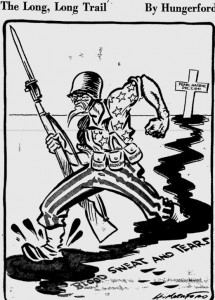
This cartoon marking the 1st anniversary of Pearl Harbor appeared 75 years ago today in the Pittsburgh Post-Gazette, Dec. 7, 1942.
Pearl Harbor Anniversary
Today marks the 76th anniversary of the attack on Pearl Harbor, December 7, 1941, marking the entry of the United States into World War II.
The Peace Light
As a symbol of peace, we show the flame above, which has been burning for hundreds of years. This flame was burning throughout the Second World War, the First World War, the U.S. Civil War, and every other war in modern history. It’s shown here in my living room, but it originates from the Church of the Nativity in Bethlehem, where it has been continuously tended for hundreds of years. The exact date that some monk struck a flint to ignite it is not known, but it is believed to be about a thousand years ago.
Each year during the Advent season, it is transported from Bethlehem to Europe and North America, courtesy of Austrian Airlines. This year, it was brought to Kennedy Airport on November 25. From there, volunteers fan out across the country to distribute the flame. Most of these are connected with Scouting in some way, and Scouts and Guides in Europe participate in similar activities.
As I did last year, I played a small part in the distribution. Prior to my getting it, the flame traveled to Indianapolis, and then to Chicago. From there, it went to Des Moines, and I met an Iowa Scouter in Albert Lea, Minnesota, to transfer it to St. Paul. From me, it was picked up by others who took it to Wisconsin and North Dakota. From there, it will travel to Winnipeg, and probably to other points. Meanwhile, others are taking it to other parts of the United States, Canada, and Mexico.
You can read more about the Peace Light at the U.S. Peace Light website or the Peace Light North America Facebook group. If you’re close to St. Paul, Minnesota, and would like to receive the Peacelight, feel free to contact me and we can make arrangements. In other areas, you can find a local source on the Facebook page.
Lanterns
One common question is how the Peace Light travels on two international flights from Israel to Austria, and then to North America. The flame is transported safely in an antique blastproof miner’s lamp. On the ground, it is walked through customs by airline employees to the airport chapel.
On the ground, the most common way to transport the light is with a lantern such as the one at the top of the page. These are rarely used these days, since mantle type lanterns provide considerably more light. But in the 19th century, the cold-draft kerosene lantern was something of a revolution in lighting, since it provides a fairly bright flame and is also relatively safe, since it will self-extinguish if tipped over.
A good history of the lantern can be found at this site. Prior to such lanterns, the best available option for camp lighting was the candle lantern. As the name implies, it was just a ventilated enclosure in which a candle was inserted.
The ad at the left, from the June 1916 issue of Boys’ Life, shows both types of lamps. The candle lantern here is known as a “Stonebridge” lantern, since it was manufactured by a company of that name, and replicas have been made over the years. Interestingly, in addition to providing more light, the kerosene lantern is actually less expensive. Candle lanterns start at $1.50, but the cold-blast lantern is only 75 cents.
Both types of lanterns are readily available today. The cold-blast kerosene lantern can be found at Amazon at any of the following links:
You can also obtain the lantern at WalMart with this link or this link. The fuel is available at this link. You can order the lanterns and fuel online with these links, and then pick them up the same day at the store.
And for those who want to be even more retro in their camp lighting, these candle lanterns are also available at Amazon:
The replica Stonebridge lantern shown below is very similar, or possibly identical, to the 1916 candle lantern shown in the ad:

If you need to transport the flame only a short distance, one good option is to use a votive candle at the bottom of a coffee can. For longer distances, I place the lanterns at the top of the page inside a 5 gallon bucket similar to the one shown at the left, wtih sand or cat litter at the bottom.
Carrying it in this manner is very stable, and I have never experienced it tipping. If it does tip, the entire lantern is safely contained, and the lantern will self-extinguish.
It should be noted that because there is an open flame, you should not refuel the vehicle with the Peace Light in the car. Fill up your gas tank before picking up the light. If you need to buy gas before you reach your destination, it will be necessary to leave the lantern at a safe location before driving to the pumps. And while the combustion of these lanterns is very complete, it is a good idea to keep a window of the car open slightly.
Plans for a more a elaborate carrier are also available at the Peacelight.org site.
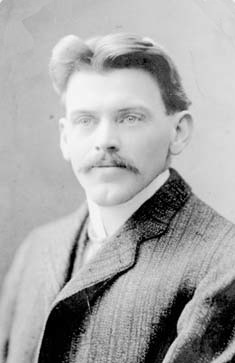
Vince Coleman. Wikipedia photo.
Today marks the 100th anniversary of the Halifax Explosion, December 6, 1917. We remember it as a great act of heroism by a telegrapher, train dispatcher Vince Coleman.

Only known photograph of the blast, probably taken about 15 seconds after detonation from about one mile away. Wikipedia photo.
The 1917 explosion in Halifax harbor killed approximately 2000 people and injured 9000 more. It represented the largest man-made explosion prior to the development of nuclear weapons, and released the equivalent of 2.9 kilotons of TNT.
It was the result of a collision between the SS Mont-Blanc, a French freighter carrying high explosives, with the Norwegian vessel SS IMO. The Imo was en route to New York to take on relief supplies for Belgium. The ship was given clearance to leave the harbor on December 5, but had been delayed due to fueling. By the time the ship had taken on fuel, the submarine nets were up for the night, and the ship had to wait.
The Mont-Blanc had arrived from New York the night of December 5 and was heavily loaded with explosives. The ship intended to join a convoy, but was also arrived too late to enter the harbor due to the submarine nets.
When the nets were lowered the next morning, the ships passed in a strait called the Narrows. At 8:45 AM, the two ships collided. While damage was not severe, barrels of Benzol broke open and flooded the hold. Sparks ignited the vapors, and a fire started at the water line. As the crew of the Mont-Blanc frantically boarded their lifeboats, they shouted warnings that the ship was about to explode.
At 9:04, the ship exploded, with a cloud of smoke rising over 11,000 feet. The shock wave was felt over 129 miles away, and an area of over 400 acres was completely destroyed. A 50-foot tsunami hit Halifax.

Halifax ruins. Wikipedia photo.
Vince Coleman, 45, was a dispatcher for the Canadian Government Railways. He, along with Chief Clerk William Lovett, was working at the Richmond station, only a few hundred feet from the pier. He was responsible for controlling trains along the main line into Halifax.
Minutes after the fire started, a sailor had been rushed ashore to warn people of the ship’s cargo. The men in the station began to rush out of the building, but Coleman hurried back to send a warning message to the other stations down the line. In particular, Coleman was aware that a passenger train was due, and that its path would take it right to the explosion. He sent the following message to all of the other stations down the line:
HOLD UP THE TRAIN. AMMUNITION SHIP AFIRE IN HARBOR MAKING FOR PIER 6 AND WILL EXPLODE. GUESS THIS WILL BE MY LAST MESSAGE. GOOD-BYE BOYS.
The message was heeded. The passenger train, with 300 aboard, was halted at Rockingham station, about 4 miles from the downtown terminal. It is almost certain the Coleman’s message saved the lives of those 300 passengers. In addition, the message, which was received by numerous other stations, along with the line then going silent, gave news of what had happened, allowing relief supplies to be immediately sent to Halifax.
This was critical, since a winter storm soon delayed further relief supplies. The passengers and crew of the first arriving trains began rendering assistance, but the first dedicated relief train was udnerway by 10:00 AM, and arrived by noon.
The next day, Halifax was blanketed by 16 inches of snow, delaying other relief trains from Canada and the United States. Coleman’s heroic message ensured that relief was on the way while there was still time to save hundreds of lives.
This short video dramatizes Coleman’s heroism:
It also features in the 2007 miniseries “Shattered City: The Halifax Explosion”:
References
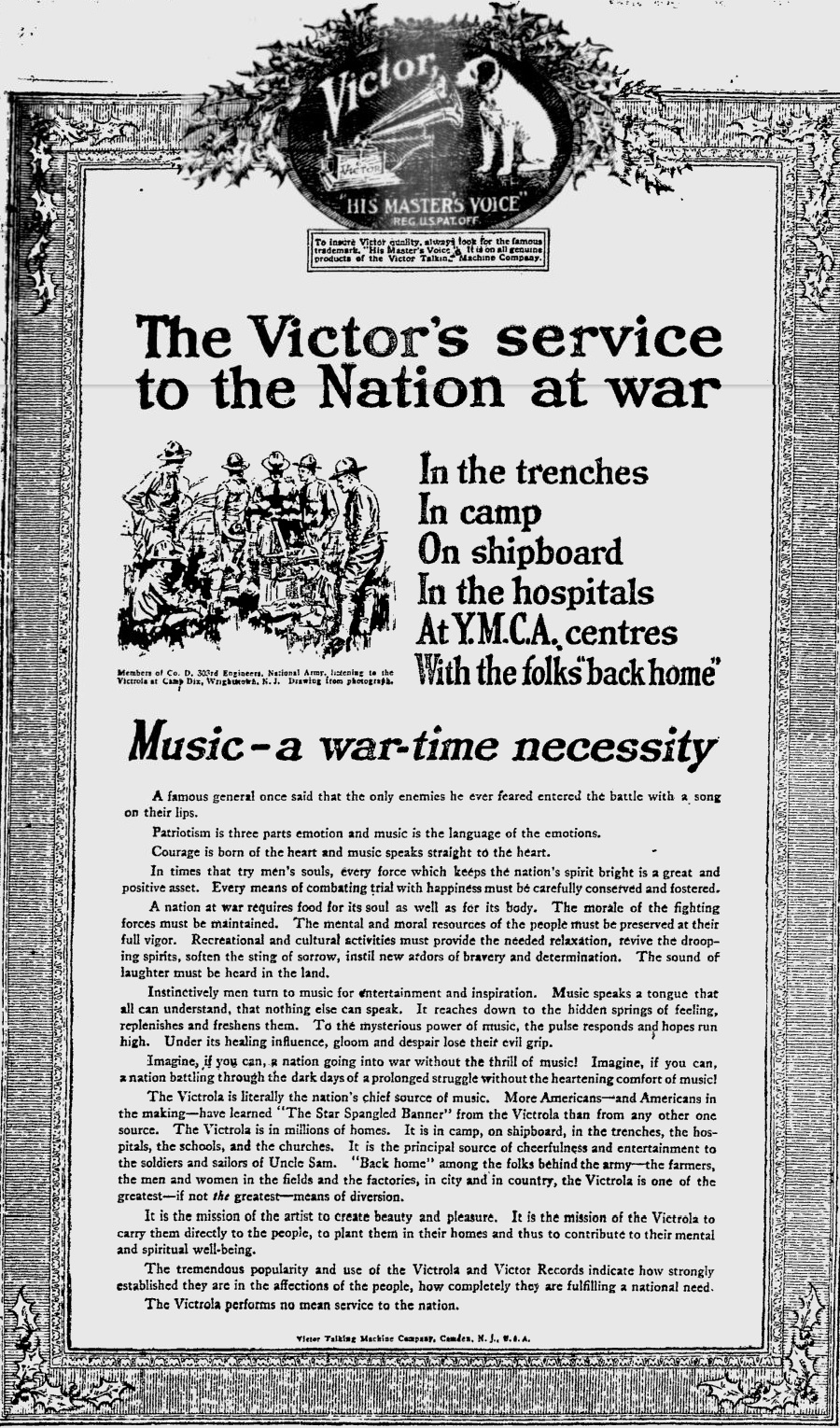 With the nation at war, the Victor Talking Machine Company was doing its patriotic duty by cranking out phonographs and records. This ad appeared in the Pittsburgh Press a hundred years ago today, November 26, 1917.
With the nation at war, the Victor Talking Machine Company was doing its patriotic duty by cranking out phonographs and records. This ad appeared in the Pittsburgh Press a hundred years ago today, November 26, 1917.
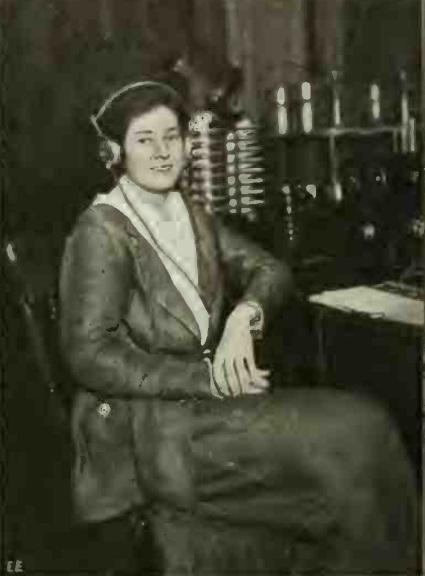 Shown here, from the November 1917 issue of Electrical Experimenter,
Shown here, from the November 1917 issue of Electrical Experimenter,
is Miss Elizabeth Rickard, the first woman to graduate as a radio operator from Hunter College, New York City. According to the magazine, she received her first grade commercial license.
The school had a “very enthusiastic wireless class who are blest with every provision for quickly assimilating the intricacies of radio telegraphy.” The Marconi company had presented the college with standard receiving and transmitting equipment, as well as instructors.
Miss Rickard entered the college’s wireless class in April 1917, and in May of that year, she was detailed to the Marconi school for intensive training. She passed her tests in July, with the highest scores of the class of 20 men and 3 women.
Seventy-five years ago today, November 11, 1942, was the nation’s first wartime remembrance of Armistice Day.
The two pictures shown here appeared in that day’s Pittsburgh Press, showing a parade of 20,000 men who marched in celebration of the end of the last war. The included both the veterans of the First World War, along with their comrades fighting the Second.
The newspaper noted that the parade, which had been underway for an hour, halted at 11:00 AM while buglers sounded Taps in “an official and solemn recollection of the end of the last war, the tribute to the honored dead of that war, and, it seemed, a spiritual pledge of victory in the new and immensely greater war.”
Before the kids had video games, they kept themselves occupied with things like paper dolls, and this Halloween set from the October 1917 issue of Ladies’ Home Journal was practically guaranteed to keep the little goblins busy. The magazine suggested that the page could be mounted on muslin or linen before cutting, which would make sure they would last longer without the tabs tearing quite so easily. The magazine also suggested that a one inch strip of cardboard at the waistline, bent slightly, would allow the dolls to stand. A slit can be cut along the dotted line on the hats, allowing them to slip on to the respective doll.
Another article in the magazine stated that despite the war, there should be some pleasure, and suggested some party ideas for Halloween.
By clicking on the image above, you can get a full-size image in case you want to try your hand with some century old paper dolls.
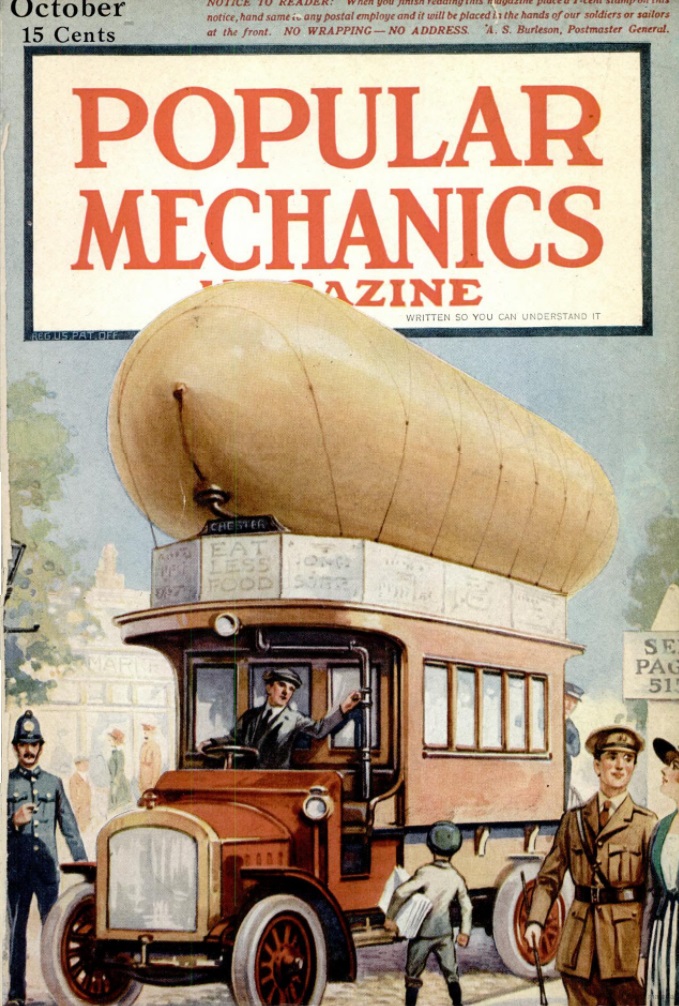 A hundred years ago, wartime conditions in England were such that there weren’t sufficient liquid fuels (gasoline or methyl alcohol) to run the buses. Undaunted, they switched to the same gas that was used to run the streetlights, conveniently stored in rooftop bags, as shown on the cover of the October 1917 issue of Popular Mechanics.
A hundred years ago, wartime conditions in England were such that there weren’t sufficient liquid fuels (gasoline or methyl alcohol) to run the buses. Undaunted, they switched to the same gas that was used to run the streetlights, conveniently stored in rooftop bags, as shown on the cover of the October 1917 issue of Popular Mechanics.
Complete information was apparently not available to the editors of the American magazine, since they noted that “the amount of power obtained from the lighting gas depends upon a number of things, and a reliable estimate could not be made without more detailed information thanis at hand. It is also not altogether clear why unwieldly bags are being used instead of compact steel cylinders which could carry gas under high pressure.”
But since the streets were already wired for gas, adding filling stations along the route was a minor matter. Indeed, some of the filling stations consisted merely of existing lamp posts situated near the curb.
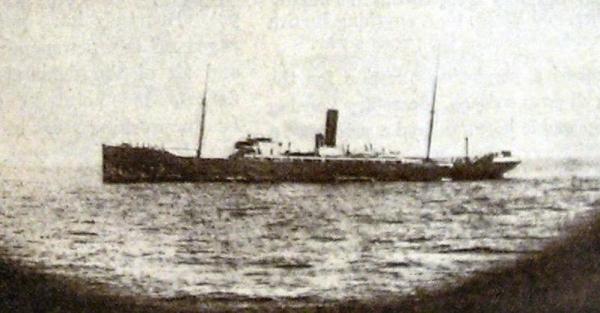
Commerce raider SMS Möve. Wikipedia photo.
A hundred years ago today, the October 16, 1917, edition of the Chicago Tribune carried the story of Walter Smith of Norway, Connecticut. Earlier in the year, Smith, who had worked as a brakeman on the New Haven railroad, signed on as a muleteer on the British Cargo steamer Esmeraldas, which was sailing from Newport News to Liverpool with a cargo of 950 horses. At about 2:00 AM on March 10, the twelfth day of the voyage, the ship was overtaken by the German commerce raider SMS Möwe, shown above.
Smith was awakened by another crew member who announced, “they’ve got us,” to see the Möwe lying astern. Smith reported that the Möwe “looked like a tramp steamer, but it could travel, believe me. It had eight guns forward under a folding deck, and when it fought they raised the ship sides. They lowered them after battle and then it looked harmless.”
Soon, the ship was swarming with Germans, three of whom carried bombs. They took the 350 crew and passengers off and proceeded to blow up the Esmeraldas.
Smith reported that the prisoners were treated well aboard the Möwe, but also served as unwitting participants in five more battles as the Möwe continued her raids. On March 21, the ship reached harbor at Kiel, which was “full of warcraft, battleships, and hydroplanes, and it was a pretty sight to watch the hydroplanes darting down to the water like gulls.” The prisoners remained in Kiel for four days, and then another two weeks in Durmen. From there, they were taken to a prison camp near Brandenburg on April 4, and “we were in that dump until early in May. They pushed us and shoved us a good deal and called us swine and some other things.” Food consisted of “one chunk of bread daily and turnip soup. That turnip soup was good water spoiled.”
At some point in May, Smith and several hundred other prisoners were transferred to Lubeck, where they were put to work on the docks loading ships bound for Sweden. When the German freighter Undine was being loaded, Smith came up with his escape plan.
Prisoners were marched to the deck in groups of twelve at 6:00 AM, but Smith noted that men who had reported sick were not seen until later in the morning. So Smith reported himself sick. When the men were marched to the dock the next morning, he waited until a group had been counted, and then slipped in. The guards didn’t bother counting during the march, and they didn’t expect an extra man. At the dock, he joined in the loading. As soon as he was aboard, he hid himself in the hold along with the load of fertilizer. He remained there from Saturday morning to Friday morning of the next week. “It was dark, but I had a pocket lamp that lasted quite a while.”
Smith had brought some food, some crackers, but didn’t bring any water. Therefore, he was unable to eat “because my mouth and throat got so dry I would not swallow them. I tried to eat them, but they were like sand in my mouth and would not go down. All the time I was afraid and my tongue was getting bigger and bigger. It felt a foot thick.”
A few times, Smith considered going up and turning himself in, but after remembering the conditions at Brandenburg, he decided to wait.
On Thursday night, the ship docked at Norrköping, Sweden. In the morning, “looking like a wildman, a week’s growth of beard on his face, his tongue swolen from six days’ raging thirst, eyes blazing with fever, body shaking with nervous chills, but still full of fight,” Smith made a leap from the deck of the ship into the arms of a Swedish dock policeman. The Swedish stevedores, realizing the situation and manifestly sympathetic, shouted to the policeman to hustle Smith away from the ship.
After Smith’s imploring gestures, he was ushered to a hydrant “where he thinks he must have drunk a gallon of water without stopping, the policeman patting him on the shoulders the while.” He was taken to the police station and a telegram was sent to the U.S. Consulate in Stockholm.
The Chicago Tribune correspondent and a few others chipped in to buy Smith a suit of clothes, after which “Smith began to look really respectable.” The American Vice Consul went to the station to get Smith, saying that “I thought he’d proved himself a good American and deserved welcome,” and the consulate was making arrangements to send him home.
The following German propaganda film shows a number of the exploits of the Möwe, which was the most successful German raider of both wars.

The Underworld: Taking cover in a Tube Station during a London air raid. Imperial War Museum. © IWM (Art.IWM ART 935)
One hundred years ago today, the September 25, 1917, issue of the Chicago Tribune carried this headline of a German air raid earlier that day (3:00 AM London time) on London.
The newspaper reported that the first raid was made by airplanes and resulted in six deaths and about twenty injuries. This was followed by a Zeppelin attack which first appeared off the coast of Lincolnshire and Yorkshire.
The British government had set up a rudimentary civil defense organization in the summer of 1917, with about 200 observation posts set up. They reported by telephone to military headquarters, and fighter squadrons and spotlights were called into action to shoot down the invading craft. Street lights in central London were turned off at night, and a lake was drained to prevent its distinctive shape from serving as a landmark.
There was, however, no method in place to warn civilians. However, civilians knew that the Germans needed moonlight and good weather. Therefore, many Londoners took shelter in underground stations on nights when bombing seemed likely. It was estimated that some 300,000 Londoners took refuge in these stations, with another half million in their cellars.
References